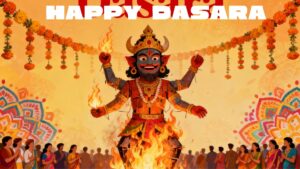Embark on a spiritual journey with the revered Hindu goddess, known for her divine blessings and powerful presence. Maa Chandraghanta is worshipped for her grace and protection.

The significance of Maa Chandraghanta lies in her association with spiritual growth and self-reflection. Devotees follow specific rituals and practices during Navratri celebrations to seek her blessings.
Understanding the mythology and symbolism surrounding this goddess provides a deeper insight into her importance in Hinduism.
Key Takeaways
- Understanding the significance of Maa Chandraghanta in Hinduism
- Exploring the mythology and symbolism associated with the goddess
- Learning about the spiritual practices and rituals followed during Navratri
- The importance of self-reflection and spiritual growth
- Seeking divine blessings and protection through worship
The Divine Identity of Maa Chandraghanta
Maa Chandraghanta, a revered goddess in Hindu mythology, embodies the perfect blend of bravery and serenity. Her divine identity is multifaceted, reflecting various aspects of her personality and significance in religious practices.
Origin and Mythological Significance
The origin and mythological significance of Maa Chandraghanta are deeply rooted in Hindu scriptures. She is considered a powerful deity, often depicted riding a tiger or a lion, symbolizing courage and strength. This imagery signifies her role as a protector and a fierce warrior against evil forces.
Symbolism and Iconic Appearance
The symbolism and iconic appearance of Maa Chandraghanta are equally significant. Her ten-armed divine form represents her ability to perform multiple tasks simultaneously, showcasing her omnipotence.
The Half-Moon on Her Forehead
The half-moon on Maa Chandraghanta’s forehead, shaped like a bell, symbolizes peace and serenity. This distinctive feature is a hallmark of her iconic appearance, signifying her ability to balance ferocity with tranquility.
Maa Chandraghanta’s ten-armed form is a representation of her multifaceted capabilities and her role as a protector. Each arm is believed to signify a different aspect of her power, from bestowing blessings to vanquishing evil.
Understanding the divine identity of Maa Chandraghanta provides insights into her worship and significance in Hindu mythology. Her unique blend of strength and serenity makes her a revered figure among devotees.
Spiritual Practices and Worship of Maa Chandraghanta
Devotees of Maa Chandraghanta observe various spiritual practices and rituals to seek her blessings and protection. The worship of Maa Chandraghanta is an integral part of Navratri celebrations, where devotees come together to perform special pujas and offer prayers.
Navratri Celebrations and Rituals
During Navratri, devotees fast, perform special pujas, and engage in various rituals to invoke the goddess’s blessings. The celebrations are marked by traditional dances, music, and the recitation of sacred texts.
Traditional Offerings and Prayers
Devotees offer prayers and traditional offerings such as flowers, fruits, and sweets to Maa Chandraghanta. The chanting of mantras and the recitation of the Devi Mahatmyam are also considered essential aspects of her worship.
Temples and Sacred Sites in India
Maa Chandraghanta is worshipped in various temples across India, with notable sites in Varanasi and Haridwar. Devotees visit these sacred sites

The worship of Maa Chandraghanta is a vibrant and meaningful experience for devotees, fostering a deep connection with the divine.
Conclusion: Embracing the Blessings of the Goddess
Maa Chandraghanta is a revered goddess in Hinduism, known for her divine blessings and protective nature. Through her worship and spiritual practices, devotees can invoke her blessings and experience spiritual growth. The significance of Maa Chandraghanta lies in her ability to dispel negative energies and bring peace and prosperity to her devotees.
By understanding the mythology, symbolism, and spiritual practices associated with Maa Chandraghanta, we can deepen our connection with the goddess and experience the transformative power of her divine blessings. As we embrace the goddess worship in our lives, we can cultivate a sense of inner peace and spiritual growth, leading to a more fulfilling and meaningful life.
The worship of Maa Chandraghanta serves as a reminder of the importance of seeking divine guidance and blessings in our lives. By embracing her blessings, we can navigate life’s challenges with courage and confidence, and cultivate a deeper sense of spirituality and connection with the divine.
FAQ
Who is Maa Chandraghanta?
Maa Chandraghanta is a revered Hindu goddess known for her divine blessings and powerful presence. She is the third form of the Navdurga, a group of nine goddesses worshipped during Navratri celebrations.
What is the significance of the half-moon on Maa Chandraghanta’s forehead?
The half-moon on Maa Chandraghanta’s forehead signifies her peaceful and serene nature. It is also a symbol of her association with the moon and its calming effects.
How is Maa Chandraghanta worshipped during Navratri?
Devotees worship Maa Chandraghanta during Navratri by observing fasts, performing special pujas, and offering prayers to the goddess. They also gather at temples and sacred sites dedicated to Maa Chandraghanta.
What are the traditional offerings made to Maa Chandraghanta?
Traditional offerings made to Maa Chandraghanta include flowers, fruits, and sweets. Devotees also offer prayers and perform pujas to invoke her blessings and protection.
Where are the major temples and sacred sites dedicated to Maa Chandraghanta located?
Major temples and sacred sites dedicated to Maa Chandraghanta are located in various parts of India, including Varanasi and Haridwar. These sites are considered sacred and are visited by devotees from all over the country.
What is the significance of Maa Chandraghanta’s ten-armed divine form?
Maa Chandraghanta’s ten-armed divine form represents her ability to perform multiple tasks simultaneously. It symbolizes her power and strength, as well as her ability to protect and bless her devotees.





